
Originally delivered as a talk at San Diego State University for the Futures Past & Present exhibition.
It appeals to my sense of coincidence to be giving this talk in 2019, the year in which Ridley Scott’s Blade Runner takes place. Of course, the film came out and underperformed in theaters in 1982, a couple of years before I was born, but by the time I became a Blade Runner fan myself, the world had long since caught up with it.
In film, in literature, in comics, in video games, and in much else besides, we would now be hard pressed to find a vision of the urban future not influenced by Blade Runner‘s imagined Los Angeles of 2019: its shadowy forest of high-rises; its multi-ethnic, polyglot crowds; its multi-ethnic, polyglot advertisements, illuminating the streets from enormous video screens mounted on those high rises; its stark division between the lower classes relegated to those streets and the upper classes who have escaped not just high above them but indeed off the Earth entirely.

In the real 2019, how much of this come to pass? Even if Angelenos don’t quite live in a concrete Babel of perpetual night and perpetual rain, something in the urban future crafted by Scott and his many collaborators, and originally inspired by the writing of Philip K. Dick, tapped into a primal fear felt by its viewers, especially viewers in the West. I’m told that in the real Los Angeles of the 1980s and 90s, opponents of a denser, taller built environment threw around the term “Blade Runner-ization” with nearly the frequency and scorn with which they, or those of their number who remain, still today throw around the term “Manhattanization.”
Some of that sentiment came out of the dominant American economic anxieties of the day, having to do with the newly staggering wealth of Japan — staggering on paper, at least — and the question of how much of America Japan intended to purchase with that wealth.
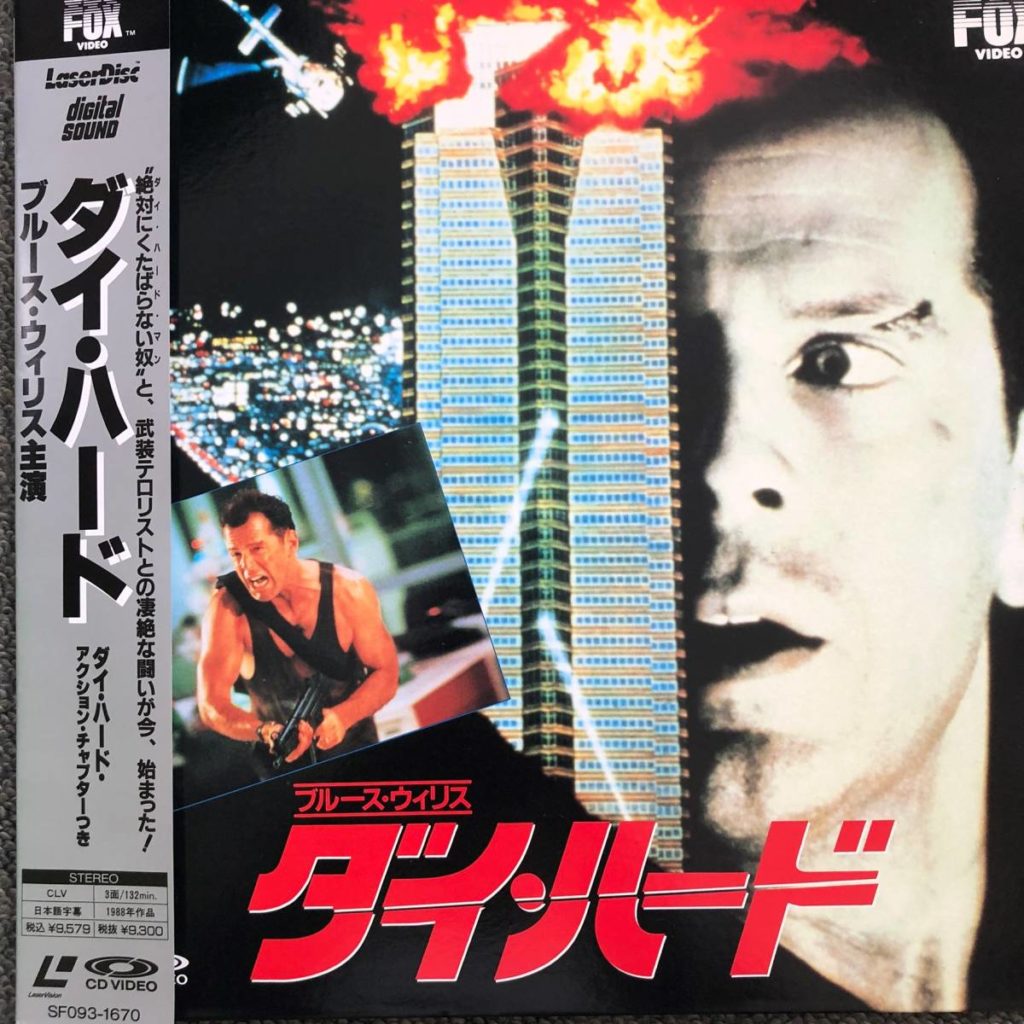
By the time of Blade Runner, Japanese conglomerates had already put money into downtown Los Angeles skyscraper construction, among other concerns, but going by the signage on display in the movie, Japan would within 40 years own more or less the entire city. Other films of the 1980s made use of this fear as well, sometimes more subtly: recall, to name another Los Angeles example, how Die Hard cast Century City’s Fox Plaza as the besieged Nakatomi Plaza.
Decades after the bursting of Japan’s asset bubble at the beginning of the 1990s, this all looks rather quaint, but Blade Runner itself has held up well enough to inspire a sequel, 2017’s Blade Runner 2049, that retains and even intensifies the sensibility of the original film. Excited speculation about another Blade Runner had been going on even before I discovered the first one, but I have to admit that I looked upon the prospect of a sequel with some trepidation, not just as a potentially inferior thematic or aesthetic enterprise, but as a potentially inferior Los Angeles movie as well.
After years of growing fascination with the city at an ever-decreasing distance, I decided to move to Los Angeles in 2011. But I’ve often wondered if those years of fascination were actually, on some subconscious level, decades of fascination, first sparked by Blade Runner and its use of Los Angeles’ already distinctive urban form to create an even more distinctive urban future.

Growing up in the suburbs of Seattle, I was, like many around the world, totally ignorant of the southern Californian metropolis apart from what I picked up, almost subconsciously, from countless movies shot there, whether they were actually set in Los Angeles or not. Taken together, everything I’d happened to not just see but hear or read suggested a city magnetic yet loathed; a city with no culture containing nearly all cultures; a city that wasn’t really a city, or so it was claimed by detractors and boosters alike; a city too big to comprehend, let alone know: a city, in other words, that laid down an irresistible challenge.
We catch glimpses Los Angeles through the movies, but we can also gain an understanding of Los Angeles through the movies — or at least I took that as a premise when first I lived there. I began with Los Angeles Plays Itself, a three-hour-long video essay by a CalArts professor named Thom Andersen that cuts together hundreds of the ways Los Angeles has been portrayed — or in any case, used — throughout the history of cinema up to the early 2000s.
That time, recall, was before the advent of Youtube, Vimeo, and other online video streaming platforms that have in this decade turned the video essay (if not yet the three-hour video essay) into a newly viable form. That and the fact that a fair few notable cinematic visions of Los Angeles had come out between the release of Los Angeles Plays Itself and my own move to the city — Michael Mann’s Collateral, Richard Kelly’s Southland Tales, Nicolas Winding Refn’s Drive — convinced me to launch my own exploration of Los Angeles through film for the streaming-video era: Los Angeles, the City in Cinema.

I also wanted to revisit for myself some of the many pictures only touched on by Thom Andersen, in between the more thorough treatments his essay gives to the mythologized Los Angeleses of Chinatown, of Who Framed Roger Rabbit, of L.A. Confidential — and indeed of Blade Runner, a Los Angeles that I recognized from the beginning as essential to my project as it was to Andersen’s.
The dissolution of the economic fears that went into Blade Runner‘s urban environment reveals its aesthetic legacy that much more clearly. If the film drew much of its look and feel from Tokyo, it in turn provided an even greater inspiration to Japanese visions of the future. Take, for instance, the late-1980s animated series Bubblegum Crisis, which takes place in the Tokyo — or rather, the “Megatokyo” — of the year 2032, a city that, to any Blade Runner fan, may look and sound oddly familiar.
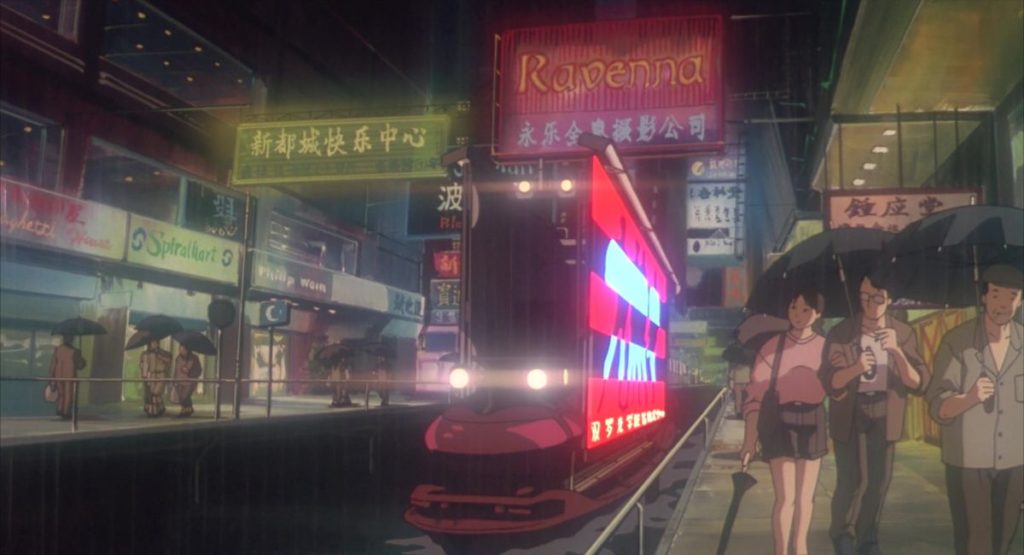
In 1995, Oshii Mamoru’s animated film Ghost in the Shell dealt with questions of consciousness and individuality in a world with not only the technology to build artificial human bodies but to transplant minds between those bodies as well. These themes hardly lie a million miles from those of Blade Runner, and the settings of both pictures have much in common as well.
Instead of Los Angeles, or even Tokyo, Oshii gives the full cyberpunk treatment to Hong Kong, turning it into a megalopolis of high tech and low life called “New Port City.” The high point of the film — and, for my money, the high point of Japanese animation thus far — comes in the middle, a three-minute montage with neither action nor dialogue that, in revealing and bringing to life New Port City, achieves an ideal union of setting, character, and theme.

Blade Runner takes place in 2019, which in 1982 was of course the future — and the future, to coin a phrase, is now. It surprised me, in the promotional materials for Futures Past and Present, to see that line attributed to the Korean artist Nam June Paik, because despite having long enjoyed his work, I had no idea he’d played a part in popularizing such a well-known English saying — let alone one I find myself using more often, and less ironically, the deeper we find ourselves in the 21st century. In my own writings about Paik’s native Korea, where I now live, I credit him with foreseeing what I call the “society of screens,” a concept with which anyone who has taken a ride on the subway in any east Asian metropolis will be well familiar.
Paik died in 2006, at the dawn of our era of omnipresent streaming video, but I like to think he would have felt at home in it. He may also have felt at home in the Los Angeles of Blade Runner. On the first day of 1984, he masterminded a live international New Year’s Day television broadcast called Good Morning, Mr. Orwell, a celebration of not just video technology but, in Paik’s own eyes, the fact that the dystopian future envisioned in Orwell’s novel had failed to materialize.
Angelenos who experienced the time of the brightly colored (and profit-making) Summer Olympics of 1984 all, in my experience, tend to remember it as a high-water mark for the city. Los Angeles would regain its dystopian image in the 1990s by emblematizing urban dysfunction, natural disaster, racial strife, and crime both high-profile and low, a perception reflected and even exaggerated by films like Lawrence Kasdan’s Grand Canyon, Joel Schumacher’s Falling Down, and — written in the early 1990s but not produced until the mid-2000s — Paul Haggis’ Crash.

Now, in the late 2010s, Los Angeles has oscillated back to a broad positivity, not least because of the 21st-century resurrection of its downtown, long occupied by primarily by office workers during the day, the poor during the night, and at various times film crews there to make use of its architecture, both its gleaming new corporate towers and its handsome but then-deteriorating examples from the early 20th century. 2019 finds it downtown Los Angeles home not to Blade Runners and tower-side video geishas but, increasingly, to a population of young professionals and the high-end grocery stores and coffee shops that cater to them.
Above it all stands the Wilshire Grand Center, which opened in the summer of 2017 as the new tallest building in Los Angeles. Owned by the Korean conglomerate Hanjin, it bears the logo of Hanjin’s subsidiary Korean Air — and so 73 stories above Los Angeles glows the airline’s red-and-blue logo, all similarities to a certain national flag being, of course, entirely coincidental. Will the downtown skyline show us that the humbling of the Japanese zaibatsu of the 1980s has led only to the victory of the Korean chaebol today?

But then the American media, so far as I can tell at my transpacific remove, reserves its darkest intimations for the rise of China. 2013 brought us a cinematic vision of a Sinicized Los Angeles in Spike Jonze’s Her. Its story of a man in love with an artificial intelligence takes place in quite possibly the most thoroughly realized Los Angeles future on film since Blade Runner, a digital hybrid of the built environments of Los Angeles and Shanghai, joined to create not an urban dystopia but, at least on the surface, an urban utopia.
Incidentally, when I first saw Her, I saw it in a classically Los Angeles fashion, watching it on an Academy Awards “for your consideration” screener disc with friends, at the house of one of them whose father works in the entertainment industry. The train lines now in operation in greater Los Angeles are more numerous and farther reaching that most outsiders (or even many Angelenos) realize, but as soon as this imagined rapid-transit map appeared onscreen, we instinctively paused the movie to marvel at it. That map, more than anything else, made the Sinicization of Los Angeles an appealing prospect — an infrastructural Sinicization, if neither a cultural nor a linguistic one.

A few years before Her, Duncan Jones had already hinted at a more thoroughly Korean future, and done it more subtly, in Moon. Its central character, an astronaut assigned to oversee an automated lunar mining operation, lives in a station called Sarang — the Korean word for love, and one that appears both romanized and in the original Korean script all over the sets.
Jones later revealed that he chose that name because his girlfriend at the time was Korean, “so that was me being a bit of a romantic,” but in the recent history of Koreanized futures in Western film, Moon has proven not to be a one-off. The years after its release saw the solidification of the rumors that had swirled around the prospect of a second Blade Runner, and in late 2016 the trailer for Blade Runner 2049 gave us a promising first look at what we could expect.
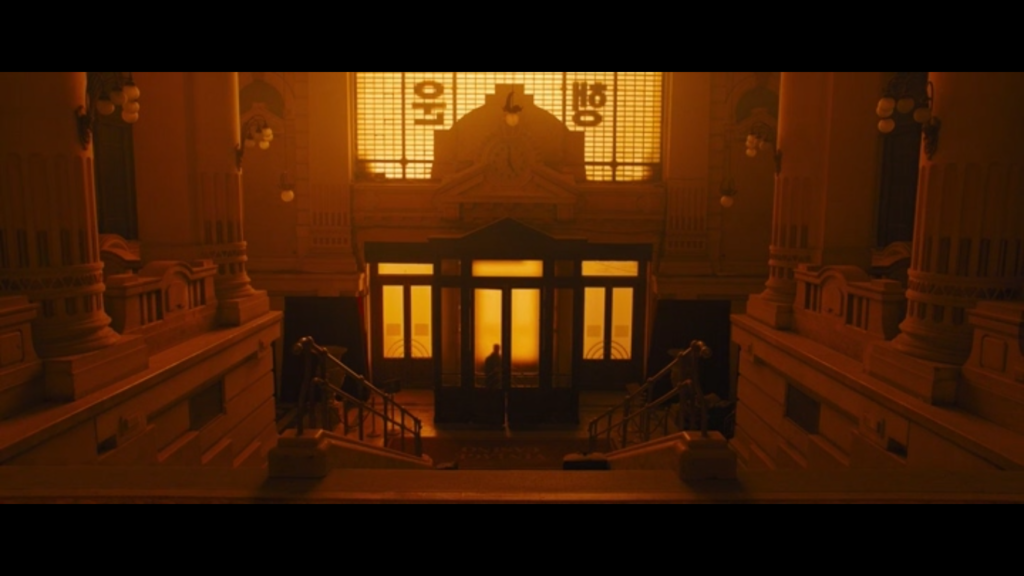
This shot in particular got me speculating in overdrive. The eyes of those of you familiar with the Korean language will go, as mine did, straight to the top of the frame — and then try to read it backward, since the text faces outward on the glass. It says haengun, or luck, a natural enough sentiment to stick on the window of what turns out, in the film, to be an abandoned casino in the blasted ruins of Las Vegas.
But to me, and no doubt to what other enthusiasts of Blade Runner, urbanism, Los Angeles, and east Asian languages exist, these two syllables suggested that the Blade Runner vision of the future had to some extent, turned Korean. Whatever my reservations about the very idea of a sequel, I couldn’t resist the chance to see how that vision turned out in the conglomerate-owned multiplex right across the street from my home in Seoul — incidentally, the same place I saw La La Land, a Los Angeles movie that became and remains quite a cultural phenomenon in Korea.

Blade Runner 2049‘s Los Angeles is a far cry from that of a romantic-comedy musical like La La Land — a far cary, in fact, from any version of Los Angeles we’ve seen before, save for the one in the original Blade Runner. But Blade Runner 2049 takes place in not so much a Los Angeles of that year as an intensification, an exaggeration, and at times almost a parody of the Los Angeles of its predecessor. It emphasizes not just a continuation of the series’ commitment to flying cars, but that the built environment of its Los Angeles, which already looked frighteningly dense to audiences in 1982, has only grown denser, and its high-rises have only grown higher.
The reactions of Blade Runner fans to the new film have varied, but no fan could object to how its production has continued using built models (combined with photography of the real Mexico City), which gives these scenes a certain physicality badly lacking in the 100-percent-CGI urban futures so often conjured up onscreen today.

On the ground, the signifiers of Blade Runner‘s urban reality appear at every turn, though the driving rains have become flurries of snow and dust, and joining the advertisements for the Off-World Colonies is a bilingual one for, of course, a Japanese Company — in this case Sony, Blade Runner 2049‘s distributor. The protagonist K lives in an apartment not entirely dissimilar to the one Rick Deckard lives in in the original Blade Runner, but rather than locating it in downtown Los Angeles’ storied (and oft-shot-in) Bradbury Building with interiors in Frank Lloyd Wright’s equally storied Ennis House, Denis Villeneuve uses a concrete apartment block in Budapest, almost all of the film’s exteriors having been shot in Hungary.

In the years after the release of the original Blade Runner, some spoke of a “Blade Runner curse,” speculating that the film had somehow visited its commercial disappointment on the brands advertised in its cityscapes. Atari, Bell, Coca Cola, Pan Am: these and other real, once-leading companies fell on hard times over the subsequent decade, and some of them into ruin. Nothing evidences Blade Runner 2049‘s commitment to extending the original Blade Runner‘s vision than the persistence of so many of those brands, despite the technological apocalypse that’s supposed to have occurred in the thirty years between the two movies. The Atari sign in particular, you’ll notice, has grown to enormous proportions.

As Thom Andersen says in Los Angeles Plays Itself, “Blade Runner has been called the ‘official nightmare’ of Los Angeles, yet this dystopian vision is, in many ways, a city planner’s dream come true. Finally, a vibrant street life. A downtown crowded with night-time strollers. Neon beyond our wildest dreams.” Alas, in the real Los Angeles of 2019, even the Korean conglomerate-owned Wilshire Grand Center still struggles for permission to play moving video on its exterior screens instead of still images.
Where the written languages of Blade Runner‘s Los Angeles are English and Japanese, not necessarily in that order, the sequel’s Los Angeles makes frequent use of a few more, including Korean and Cyrillic. In the early 1980s, Korea had developed well out of its wartime devastation, but had yet to make its debut on the world stage; the Soviet Union, America’s Cold War enemy, had no place on Blade Runner‘s streets at all, but in Blade Runner 2049 appears as just another brand to be promoted with the highest possible technology.
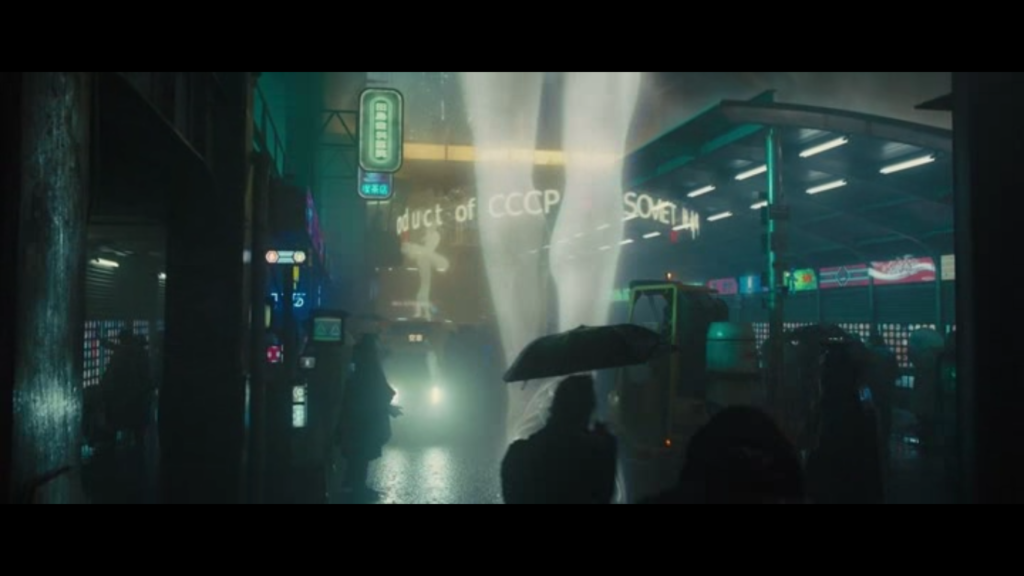
San Diego, according to Blade Runner 2049, will in three decades have become Los Angeles Municipal Waste Processing: San Diego District. But is turning into Los Angeles’ garbage dump a worse or better fate than the one envisioned in Marco Brambilla’s Demolition Man, where by 2032 the city has been wholly absorbed into a vast, totalitarian urban agglomeration called San Angeles?
Despite the imaginativeness of its choices and the impressiveness of their presentation, Blade Runner 2049 never quite convinces as a Los Angeles film, but least because it lacks even the modest ambition of the original Blade Runner — a cyberpunk update of the kind of detective dream stories Raymond Chandler told — to be a Los Angeles film in the first place.
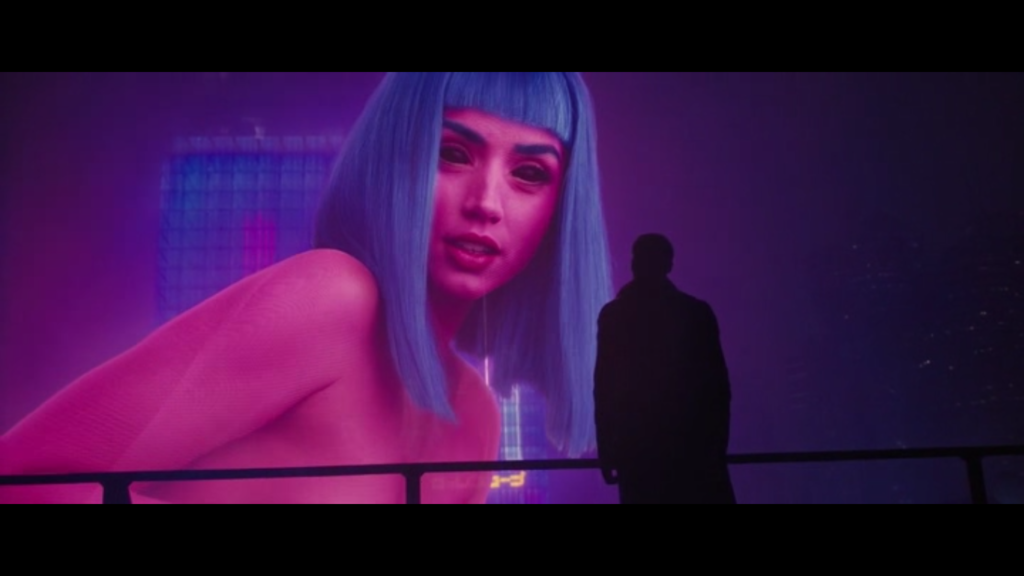
Blade Runner 2049 may present a relatively placeless urban dystopia, but it nevertheless presents a placeless urban dystopia as thoroughly realized as any in recent cinema. Signs of a climate turned violent and unpredictable are everywhere, reflecting relatively recent ecological concerns. In other respects, however, we see in the film the West still both fearing and on some level desiring the same developments it did 37 years ago: streets thronged with buyers and sellers of more or less everything imaginable, legal or otherwise, dealing in a farrago of languages and dialects, a sensory overload at once both futuristically urban and classically urban. What, after all, has the city itself always been if not a marketplace?
But Blade Runner-style urbanism has always haunted many Western viewers, and especially American viewers, with the prospect of the cities they know made foreign, plunged back into what looks and feels like what used to be called the third world. The irony in the West’s trepidation about the influence of Asian cities on those of the West is that that the 21st-century Asian city comes as the result of a modernization process that, in the 19th and 20th centuries, was more or less synonymous with the idea of Westernization.
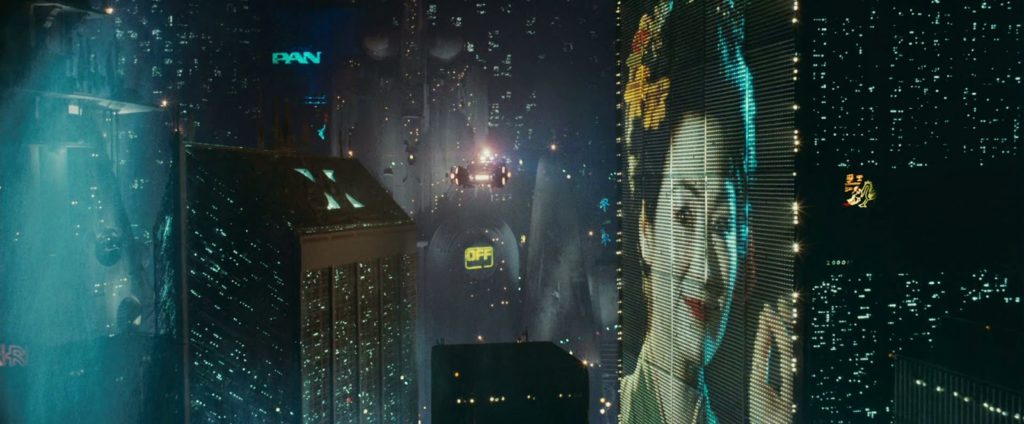
But whatever the region of the globe, whether in the past future of Blade Runner, the present future of its sequel, or the future future of a sequel to the sequel — unlikely as we are to get one, given the fact that Blade Runner 2049 racked up box office numbers as lackluster as its predecessor did — one truth holds good: sex sells. The colossal ethnically ambiguous nude holograms of the new film surely have their admirers, but I personally find more tasteful their predecessors in the original, the geisha-like figures whose video-screen appearances on the towers above 2019 Los Angeles, however brief, have come to stand in the culture for Blade Runner‘s entire urban sensibility.
These digital geishas make for another connection to Asia, not just the obvious one to Japan but a less likely one to Korea as well. One of them is played a Korean-American actress my the name of Alexis Rhee, who would nearly a quarter-century later play a part in Crash. Before the 1990s, Hollywood movies only made occasional reference to the considerable Korean presence in Los Angeles, and then often vaguely or inaccurately, but by 2005 no film seeking to capture the city — over-ambitious and even foolhardy a goal though that may be — could possibly ignore it. Doubly so in a melodrama intending to diagnose the causes of its racial discord, and so Crash finds Rhee representing Korean Los Angeles, itself a city within the city, as a anger-prone middle-aged immigrant with the highly improbable name of “Kim Lee.”
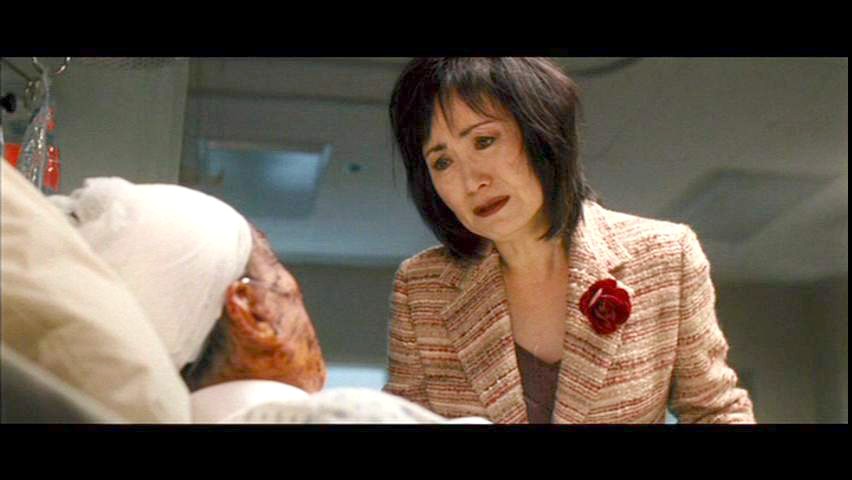
Living in Seoul, I find that many of my Korean-American acquaintances there, those who moved to Korea out of a desire to experience the ancestral homeland or moved back to experience the country of their early childhood as adults, are in some sense the sons and daughters of Kim Lee. By that I mean they grew up under immigrant Korean parents who, however imperfectly they get on in the West, have lived there for twenty, thirty, forty, years with hardly a thought toward returning to Korea themselves. If and when these Kim Lees do make the trip back to visit their wayward offspring, they tend to find that little remains of the Korea they remember, and of which they typically have a dim view indeed.

Here we have a photograph of the Korea of the 1970s, when the agrarian society of the 19th century came literally up against the high-rise development of the 20th. And here we have the Seoul of the 2010s:

These are, I underscore, real pictures of Seoul, which notably come taken not by Korean photographers but by Westerners, in this case Westerners by the names of Steve Roe and Noe Alonzo. William Gibson, whose 1984 novel Neuromancer did nearly as much as Blade Runner to define the cyberpunk aesthetic, once famously said that the future is already here, it’s just not evenly distributed.
At the time Gibson first said that, Westerners would have looked instinctively to Japan, and specifically Tokyo, to see what that unevenly distributed future might bring. But whereas the future once looked obviously Japanese, it looks less so today. One might make the argument that Chinese cities, those densely populated capitalistic battlefields raised to great heights and connected by ultramodern infrastructure seemingly overnight, show us the future, but the global imagination still seems to flinch from them.

But the longer I live in Korea, the more convinced I become that Seoul, with its omnipresent conglomerates, its distinctive combination of order contained with disorder and vice versa, and its population of 25 million that adopts and assimilates the latest personal technology without hesitation, offers more than enough material for those looking to imagine an urban future in the 2010s. At certain moments in my life in Seoul, the city strikes me as having surpassed Blade Runner, and sometimes as having surpassed Blade Runner 2049.
Every time I visit Los Angeles, I admit to feeling disappointment, frustration, and even anger at the absence of nearly all the conveniences available as a matter of course in Seoul. But it’s never long before I start imagining how Los Angeles might one day take Seoul as an example, incorporating its most desirable features but re-interpreting them in its own way. It occurs to me then that the urban future resides not in any one city, but in the way that distant cities meet one another, in life or on film.